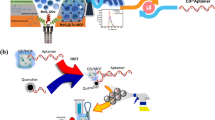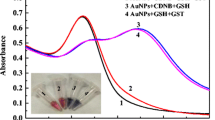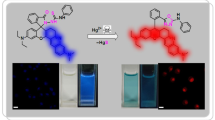Abstract
A sensitive and selective graphene oxide (GO)-based fluorescent nanoprobe has been developed for the relay recognition of Cu2+ and cysteine (Cys) by covalently grafting γ-aminobutyric acid (GABA) onto GO. The fluorescence of the probe (with excitation/emission maxima at 360/445 nm) is selectively quenched by Cu2+ via static fluorescence quenching. Fluorescence drops linearly as the concentration of Cu2+ is increased from 50 nM to 1.0 µM, and the detection limit for Cu2+ is calculated as 15 nM. By virtue of the strong interaction between Cys and Cu2+, the GO-GABA/Cu2+ complex can further sensitively recognize Cys in a “switch-on” mode. The linear range for Cys detection is from 50 nM to 1.0 µM, and the detection limit is 38 nM. The probe has low cytotoxicity, and it works well inside living cells, which is verified by the successful application in imaging of LLC-PK1 cells.

Gamma-Aminobutyric Acid (GABA) modified graphene oxide (GO) is a highly selective nanoprobe for the fluorometric relay recognition of Cu2+ and Cys.









Similar content being viewed by others
References
Qin H, Ren J, Wang J, Wang E (2010) G-quadruplex facilitated turn-off fluorescent chemosensor for selective detection of cupric ion. Chem Commun 46(39):7385–7387
Tian J, Liu Q, Asiri AM, Alyoubi AO, Sun X (2013) Ultrathin graphitic carbon nitride Nanosheet: a highly efficient Fluorosensor for rapid, ultrasensitive detection of Cu2+. Anal Chem 85(11):5595–5599
Jung HS, Chen X, Kim JS, Yoon J (2013) ChemInform abstract: recent Progress in luminescent and colorimetric Chemosensors for detection of thiols. Chem Soc Rev 42(14):6019–6031
Liu Y, Yu D, Ding S, Xiao Q, Guo J, Feng G (2014) Rapid and ratiometric fluorescent detection of cysteine with high selectivity and sensitivity by a simple and readily available probe. ACS Appl Mater Interfaces 6(20):17543–17550
Tang L, Li F, Liu M, Nandhakumar R (2011) Single sensor for two metal ions: colorimetric recognition of Cu2+ and fluorescent recognition of Hg2+. Spectrochim Acta Part A 78(3):1168–1172
Tang L, He P, Zhong K, Hou S, Bian Y (2016) A new hydroxynaphthyl benzothiazole derived fluorescent probe for highly selective and sensitive Cu2+ detection. Spectrochim Acta Part A 169:246–251
Zhu R, Zhou G, Tang F, Tong C, Wang Y, Wang J (2017) Detection of Cu2+ in water based on histidine-gold labeled multiwalled carbon nanotube electrochemical sensor. Int J Anal Chem 2017:1–8
Wu S, Lan X, Huang F, Luo Z, Ju H, Meng C, Duan C (2012) Selective electrochemical detection of cysteine in complex serum by graphene nanoribbon. Biosens Bioelectron 32(1):293–296
Yuan X, Tay Y, Dou X, Luo Z, Leong DT, Xie J (2013) Glutathione-protected silver nanoclusters as cysteine-selective fluorometric and colorimetric probe. Anal Chem 85(3):1913–1919
Ly NH, Seo C, Joo SW (2016) Detection of copper(II) ions using Glycine on hydrazine-adsorbed gold nanoparticles via Raman spectroscopy. Sensors 16(11):E1785
Zhang CH, Zhou GM, Zhang LT, Luo D, Lu YU, Gao Y (2018) An application to quantitative analysis of hg(II)with L-cysteine molecular probe by surface-enhanced Raman spectroscopy. Spectrosc Spectr Anal 38:117–122
Tang L, Ding S, Zhang X, Zhong K, Hou S, Bian Y (2017) A 2-(2′-hydroxyphenyl) quinazolin-4 (3H)-one derived fluorescence ‘turn on’probe for recognition of Hg2+ in water solution and its live cell imaging. J Photochem Photobiol A 340:15–20
Chen X, Pradhan T, Wang F, Kim JS, Yoon J (2011) Fluorescent chemosensors based on spiroring-opening of xanthenes and related derivatives. Chem Rev 112(3):1910–1956
Akhila AK, Neeroli RNK (2019) Coumarin-graphene turn-on fluorescence probe for Femtomolar level detection of copper(II). New J Chem 43(2):1001–1008
Chen D, Feng H, Li J (2012) Graphene oxide: preparation, functionalization, and electrochemical applications. Chem Rev 112(11):6027–6053
Georgakilas V, Tiwari JN, Kemp KC, Perman JA, Bourlinos AB, Kim KS, Zboril R (2016) Noncovalent functionalization of graphene and graphene oxide for energy materials, biosensing, catalytic, and biomedical applications. Chem Rev 116(9):5464–5519
Toh SY, Loh KS, Kamarudin SK, Daud WRW (2014) Graphene production via electrochemical reduction of graphene oxide: synthesis and characterisation. Chem Eng J 251:422–434
Mallakpour S, Abdolmaleki A, Borandeh S (2014) Covalently functionalized graphene sheets with biocompatible natural amino acids. Appl Surf Sci 307(27):533–542
Barrett E, Ross RP, O'Toole PW, Fitzgerald GF, Stanton C (2014) γ-Aminobutyric acid production by culturable bacteria from the human intestine. J Appl Microbiol 116(5):411–417
Flavie K, Rowley SCS, Ivan P, María GM, Alexey S, Reul JMHM, Walker MC, Linthorst ACE (2013) A functional role for both γ-aminobutyric acid (GABA) transporter-1 and GABA transporter-3 in the modulation of extracellular GABA and GABAergic tonic conductances in the rat hippocampus. J Physiol 591 (Pt 10:2429–2441
Zamborini FP, Leopold MC, Hicks JF, Kulesza PJ, Malik MA, Murray RW (2002) Electron hopping conductivity and vapor sensing properties of flexible network polymer films of metal nanoparticles. J Am Chem Soc 124(30):8958–8964
Hummer WS, Offeman RE (1958) Functionalized graphene and graphene oxide: materials synthesis and electronic applications. J Am Chem Soc 80:1339–1339
Wang F, Gu Z, Lei W, Wang W, Xia X, Hao Q (2014) Graphene quantum dots as a fluorescent sensing platform for highly efficient detection of copper(II) ions. Sensors Actuators B Chem 190(1):516–522
Lin L, Song X, Chen Y, Rong M, Wang Y, Li Z, Zhao T, Chen X (2015) Europium-decorated graphene quantum dots as a fluorescent probe for label-free, rapid and sensitive detection of Cu2+ and l -cysteine. Anal Chim Acta 891:261–268
He L, Li J, Xin JH (2015) A novel graphene oxide-based fluorescent nanosensor for selective detection of Fe3+ with a wide linear concentration and its application in logic gate. Biosens Bioelectron 70:69–73
Compton OC, Dikin DA, Putz KW, Brinson LC, Nguyen SBT (2010) Electrically conductive "alkylated" graphene paper via chemical reduction of amine-functionalized graphene oxide paper. Adv Mater 22(8):892–896
Mei Q, Zhang K, Guan G, Liu B, Wang S, Zhang Z (2010) Highly efficient photoluminescent graphene oxide with tunable surface properties. Chem Commun 46(39):7319–7322
Guo Y, Wang Z, Shao H, Jiang X (2011) Stable fluorescent gold nanoparticles for detection of Cu2+ with good sensitivity and selectivity. Analyst 137(2):301–304
Zhou Y, Zhao H, He Y, Ding N, Cao Q (2011) Colorimetric detection of Cu2+ using 4-mercaptobenzoic acid modified silver nanoparticles. Colloid Surface A 391(1):179–183
Huang S, Qiu H, Zhu F, Lu S, Xiao Q (2015) Graphene quantum dots as on-off-on fluorescent probes for chromium(VI) and ascorbic acid. Microchim Acta 182(9–10):1723–1731
Patel R, Bothra S, Kumar R, Crisponi G, Sahoo SK (2017) Pyridoxamine driven selective turn-off detection of picric acid using glutathione stabilized fluorescent copper nanoclusters and its applications with chemically modified cellulose strips. Biosens Bioelectron 102:196–203
Min JC, Jin JI, Dong HC, Yoon JH, Hong CS, Kim YM, Park YW, Ju BK (2010) Tunable emission of polymer light emitting diodes bearing green-emitting Ir(III) complexes: the structural role of 9-((6-(4-fluorophenyl)pyridin-3-yl)methyl)-9H-carbazole ligands. Dyes Pigments 85(3):143–151
Vansant C, Desseyn HO, Perlepes SP (1995) The synthesis, spectroscopic and thermal study of oxamic acid compounds of some metal(II) ions. Transit Met Chem 20(5):454–459
Zhang H, Chen Y, Liang M, Xu L, Qi S, Chen H, Chen X (2014) Solid-phase synthesis of highly fluorescent nitrogen-doped carbon dots for sensitive and selective probing ferric ions in living cells. Anal Chem 86(19):9846–9852
Wang J, Sheng LR, Zhi ZH, Wang N, Zhang Z, Huang CZ (2017) Highly fluorescent carbon dots as selective and visual probes for sensing copper ions in living cells via an electron transfer process. Biosens Bioelectron 97:157–163
Acknowledgments
This work was funded by the National Natural Science Foundation of China (No. 21705089), the Natural Science Foundation of Shandong Province (No. ZR2017MB064, ZR2018MB030), Science and Technology Program of Qingdao (No.18-6-1-83-nsh), the Project of Shandong Province Higher Educational Science and Technology Program (J17KA109) and the Research Foundation for Distinguished Scholars of Qingdao Agricultural University (No. 663-1116010).
Author information
Authors and Affiliations
Corresponding author
Ethics declarations
The author(s) declare that they have no competing interests.
Additional information
Publisher’s note
Springer Nature remains neutral with regard to jurisdictional claims in published maps and institutional affiliations.
Electronic supplementary material
ESM 1
(DOCX 630 kb)
Rights and permissions
About this article
Cite this article
Li, X., Fan, K., Kang, W. et al. γ-Aminobutyric acid-modified graphene oxide as a highly selective and low-toxic fluorescent nanoprobe for relay recognition of copper(II) and cysteine. Microchim Acta 186, 461 (2019). https://doi.org/10.1007/s00604-019-3582-7
Received:
Accepted:
Published:
DOI: https://doi.org/10.1007/s00604-019-3582-7




